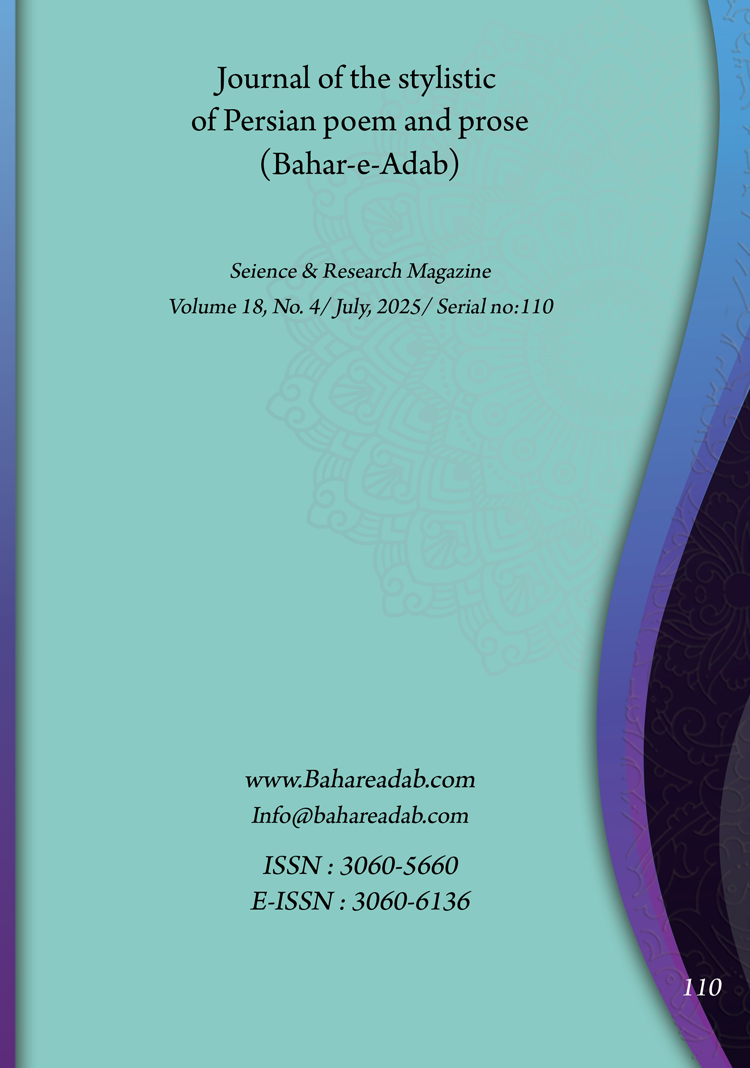- Count View : 90
- آدرس کوتاه شده مقاله: https://bahareadab.com/article_id/1846
- کد doi مقاله: Doi: 10.22034/bahareadab.2025 .18 .7874
Journal of the stylistic of Persian poem and prose
volume Number 18،
number In Volume 4،
،
issue Number 110
Analysis of similes and imagery in Qaani's odes
Ahmad Khalili (Author in Charge), Hojatollah Esmaeilinia Ganji
Abstract
BACKGROUND AND OBJECTIVES: One of the most important tools of poetic beauty is simile, which has long been considered the most frequent poetic element. Simile is actually a type of poetic experiment in which the poet, with the help of his mind, creates a proportion between two phenomena that are apparently unrelated. This issue actually indicates the power of imagination of the poets. Qaani is one of the creative poets who has used all the expressive arts, especially simile, in his poetry to express his art and creativity. This article seeks to analyze the types of simile and its constituent materials in twenty of Qaani"s odes.
METHODOLOGY: The present study is a theoretical study conducted using a library research method and has analyzed the types of similes through statistical analysis. The scope and population of the study is 20 The famous ode of Qaani, the list of sources of which is given in the introduction.
FINDINGS: Qaani has used various visual materials in his similes. In his illustrations, it is not possible to highlight a specific aspect and limit his art to it. He has experience in using all the visual tools of poetry and has used those tools in different situations to create beauty and images.
CONCLUSION: The result shows that he attaches more importance to simile than any other element, and especially sensory similes that benefit from nature and its various manifestations are very frequent in his poetry.
Keyword
Simile
, image
, Qaani
, odes.
- Aidanloo, Sajjad (2008), "The Most Familiar Persian Poet with Shahnameh", Adab Pajouhhi Magazine, Vol. 6, pp. 133-161.
- Ardalan Javan, Ali (2004), Poetic Expression of Myths and Historical and Religious Narratives in Khaghani's Poems, First Edition, Mashhad: Astan Quds Razavi.
- Arianpour, Yahya (2008), From Saba to Nima, Vol. 1, 9th edition, Tehran: Zovar Publications.
- Bahar, Malek-al-Shu'ara (2003), "Qa'ani", Armaghan Magazine, Year 14, Vol. 1, pp. 113-126.
- Ebrahimi, Mokhtar (2003), "A Study on the Imagination of Poetry in the Period of Literary Revival", Journal of Language and Literature, Faculty of Humanities, Semnan University, Vol. 6, pp. 37-54.
- Futohi Rudmoejani, Mahmoud (2006), Image Rhetoric, Tehran: Sokhan Publications.
- Hiri, Nasser (2014), Introduction to the Divan of Hakim Qaani Shirazi, First Edition, Tehran: Golshaei Publications.
- Hosseinalizadeh, Hanieh and others (2005), "Analysis and Investigation of the Manifestations of Semantic Abnormality Based on Leach's Theory in the Poems of Kiyomars Monshizadeh", Scientific Journal of Persian Poetry and Prose Stylistics, Vol. 107, pp. 149-168.
- Khatami, Ahmad (2008), A Study in Indian Style and the Period of Literary Return, 1st edition, Tehran: Baharestan.
- Majd, Omid and Tope, Maziar (2010), "The Diversity of Similarities, the Main Element of the Dynamics of Saadi's Similarities", Quarterly Journal of the Literary Achievements of the Iraqi Period, Vol. 3, pp. 93-105.
- Mohammadzadeh, Morteza (2011), Similarity and Its Materials in Khaqani's Poems, Master's Thesis in Persian Language and Literature, University of Mazandaran, January 2011.
- Pournamdarian, Taghi (2002), Journey in the Fog, 2nd edition, Tehran: Negah Publications.
- Qaani Shirazi, Habib (1984), Divan Hakim Qaani Shirazi, edited by Nasser Hiri, First Edition, Tehran: Golshaei Publications.
- Safa, Zabihullah (1998), A'in Sokhan, Second Edition, Tehran: Qoghnous Publications.
- Safaei, Ebrahim (1957), "Qaani and the Newcomers", Armaghan Magazine, Twenty-Sixth Edition, No. 12, pp. 529-536.
- Shafie-Kadkani, Mohammad Reza (2007), Imagination in Persian Poetry, 11th edition, Tehran: Negah.
- Shamisa, Sirous (2000), Expression and Meaning, 6th edition, Tehran: Ferdows Publications.
- Shams-Lengroudi, Mohammad (2003), School of Return, 1st edition, Tehran: Markaz Publications.
- Shoobakalai, Ali Akbar and Khalili, Ahmad (2011) "Aesthetic Study of Qaani's Razavi Ode", Nasim Jenan; Collection of Articles of the First Razavi Culture Conference, First Edition, Tehran: Ansari Publishing House.

